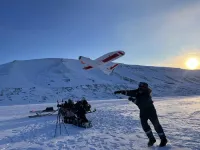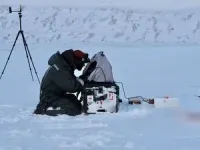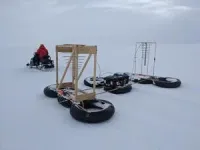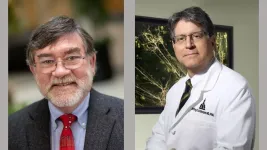(Press-News.org) Researchers in the Stanford Radio Glaciology lab use radio waves to understand rapidly changing ice sheets and their contributions to global sea-level rise. This technique has revealed groundwater beneath Greenland, the long-term impacts of extreme melt, a process that could accelerate ice sheet mass loss in Antarctica, the potential instability of an ice sheet that could raise sea levels by 10 feet, and more.
Now, PhD students within the group have created an open-source tool that others can use to make ice-penetrating radar systems, core instruments in the field of glaciology. The Open Radar Code Architecture (ORCA) offers scientists a cheaper, easier, and more efficient way to build both airborne and ground-based radars, even if they lack a technical engineering background. Ice-penetrating radars can cost tens or hundreds of thousands of dollars, while the lowest-cost version of the team’s open-source radar costs only $1,500.
“We’re enabling groups to build exactly the right instrument for what they’re trying to do,” said PhD student Thomas Teisberg, who developed the system along with Anna Broome, PhD ’24.
Whereas previous radar systems were built with specific hardware components specialized for each use case, the new model’s hardware is generic and more easily reconfigured depending on the task at hand. Broome likens the design to a kitchen mixer, with a variety of attachments available depending on what you’re planning to make. By standardizing the basic building blocks of what that radar looks like, Broome and Teisberg have also created a uniform format to store data so glaciologists can effectively reuse each other’s data.
“I think we’re going to see some really exciting and first-of-their kind experiments enabled by this system,” said Principal Investigator Dustin Schroeder, an associate professor of geophysics at the Stanford Doerr School of Sustainability. Teisberg and Broome recently co-authored a study along with Schroeder in IEEE Transactions on Geoscience and Remote Sensing that offers a blueprint for building the tool.
Seeing beyond the ice
The ice sheets and glaciers atop Greenland and Antarctica are critically important, providing habitats to wildlife, storing more than half of the planet’s freshwater, and contributing to the evolution of the climate. They’re a major contributor to the sea-level rise that threatens the 680 million people who live in low-lying coastal zones – yet the uncertainty of projections may be underestimating that threat. Earth’s ice sheets represent the largest contribution to uncertainty in average sea-level rise by 2100, according to Intergovernmental Panel on Climate Change (IPCC) models.
In order to grasp current ice loss and make projections into the future, scientists need to understand the land underneath the ice and how it impacts flows and stability. “If you want to understand how ice is going to melt and change, you need to know what the bottom of the ice sheet looks like,” said Teisberg.
Building a toolkit
Currently, scientists use a wide range of radar instruments to gather data that is subsequently analyzed and interpreted to understand how glaciers and ice sheets work. For a scientist trying to break into the field, or for those without an engineering background, it can be challenging to figure out what radar system is best suited to an intended use case. The ORCA platform is built from software-defined radio – a type of hardware that is reconfigurable using software – democratizing the ability to design customized instruments.
“If the community embraces this new tool, I think we’ll see a lot more scientists collecting their own radar data and re-using the innards of those radar systems to study really varied parts of the ice sheet that currently you would need multiple different types of radars to observe,” said Broome, who is now an R&D electrical engineer at Sandia National Laboratories.
Ice-penetrating radar is a foundational tool for glaciologists, but until now, most systems have been built by electrical engineers, not glaciologists, explained Robert Hawley, a physical glaciologist and professor of Earth sciences at Dartmouth College whose research group uses ice-penetrating radar and builds instrumentation for the frozen components of the Earth’s system. The learning curve for building hardware is very steep, he said. “By releasing their work as open-source software, Thomas and Anna have enabled a new generation of researchers to access and build ice-penetrating radars, which will spur a resurgence in this kind of research. This enables the scientists, asking the science questions, to get involved in a way that was not previously possible.”
Collecting better data
The idea for the open-source platform arose when Broome and Teisberg were separately developing plans for radar systems that map the land underneath ice sheets.
“At some point we realized, wait a minute, we could team up and build the instruments on a common core, adapt them to our needs, and save a lot of work that way,” said Teisberg.
Ice-penetrating radar acts like other radar: It sends out electromagnetic waves and records the timing of their reflections to determine an object’s distance. Ice-penetrating radar uses lower frequencies than most other radar systems and aims those waves straight down to penetrate through the ice and provide reflections off the ice surface, as well as the bedrock or sediment sitting underneath the ice.
While the tool is straightforward, flying a crewed aircraft in Greenland is no small feat – it costs a lot of money and requires a complicated set of logistics. “Our hope is that by standardizing the core of the radar, we can still allow people to build their customizations, and we can make it much easier for people to reuse data that’s been collected. By doing that, we can extract a lot more value out of every piece of data that gets collected,” Teisberg said.
The new study includes blueprints for building the two specific instruments that Broome and Teisberg engineered for their own PhD research. Teisberg is the first to admit that they have not built a new instrument. “We are standing on the shoulders of many, many people who’ve done a lot of incredible work in this field before. We’re just making an existing type of instrument much more accessible.”
To test their prototypes, Broome and Teisberg traveled to Iceland, Svalbard, and most recently to Summit Station, the National Science Foundation-run research station at the top of the Greenland ice sheet. They confirmed their functionality by comparing results with previously acquired data from those areas – and they hope their research is just the beginning. Schroeder said the open-source tool is like a gift to the glaciology community.
“I would have loved if ORCA would have been around when I was a student,” Schroeder said. “I’m really excited about the opportunities it presents for students in my own group and for glaciology students around the world.”
Schroeder is also an associate professor of electrical engineering and a senior fellow at the Woods Institute for the Environment. Teisberg is a PhD candidate in electrical engineering in the School of Engineering. This research was supported by NASA, the NSF, NDSEG, and the Heising-Simons Foundation. Additional support was provided by the TomKat Center for Sustainable Energy, Stanford University Human-Centered Artificial Intelligence (HAI), and the Stanford Data Science industrial affiliates program. Stanford industrial affiliates programs are funded by membership fees from companies. View current members of Stanford Data Science.
END
A blueprint for mapping melting ice sheets
2024-10-21
ELSE PRESS RELEASES FROM THIS DATE:
People hate stories they think were written by AI. Even if they were written by people
2024-10-21
Stories written by the latest version of ChatGPT were nearly as good as those written by human authors, according to new research on the narrative skills of artificial intelligence.
But when people were told a story was written by AI — whether the true author was an algorithm or a person — they rated the story poorly, a sign that people distrust and dislike AI-generated art.
“People don’t like when they think a story is written by AI, whether it was or not,” said Haoran “Chris” Chu, Ph.D., a professor of public relations at the University of Florida and co-author of the new study. “AI is good at writing something that is consistent, ...
From Houston to Scotland: Seed grants boosting shared energy solutions and innovations
2024-10-21
HOUSTON, Oct. 21, 2024 – The University of Houston and Scotland’s Heriot-Watt University have awarded seed grants to six innovative energy projects as part of their transatlantic research collaboration. The projects, which bring together researchers from both universities, focus on cutting-edge solutions ranging from advanced hydrogen sensing technology to converting waste into sustainable products.
“This partnership is rooted in a shared commitment to advancing research that supports a just energy ...
AI-assisted colonoscopy increases polyp and adenoma detection in routine screening
2024-10-21
Embargoed for release until 5:00 p.m. ET on Monday 21 October 2024
@Annalsofim
Below please find summaries of new articles that will be published in the next issue of Annals of Internal Medicine. The summaries are not intended to substitute for the full articles as a source of information. This information is under strict embargo and by taking it into possession, media representatives are committing to the terms of the embargo not only on their own behalf, ...
Younger adults respond to colorectal cancer screening outreach
2024-10-21
The updated national colorectal cancer screening guidelines that recommend screening begin at age 45 — rather than 50 — can benefit younger adults, a new Kaiser Permanente study found.
The study, published October 22 in Annals of Internal Medicine, included more than 267,000 Kaiser Permanente members in Northern California, Washington, and Colorado ages 45 to 50 who received their first invitation for colorectal cancer screening along with a fecal immunochemical test (FIT) kit between January and September 2022.
“The U.S. Preventive Services Task Force lowered the age to start screening in response to studies showing an increased rate of colorectal cancer in ...
UT Health San Antonio world-renowned expert in BRCA research to be honored for global contributions
2024-10-21
SAN ANTONIO, Oct. 21, 2024 – Patrick Sung, DPhil, director of the Greehey Children’s Cancer Research Institute and associate dean for research at The University of Texas Health Science Center at San Antonio (UT Health San Antonio) is the latest recipient of the 2024 Basser Global Prize.
A leading researcher in the field of DNA damage repair and cancer biology, Sung has been awarded the prestigious prize for his groundbreaking contributions in elucidating the DNA repair functions of the BRCA1 and BRCA2 genes. The award recognizes Sung’s contributions in advancing the knowledge of these critical genes and their implications for hereditary ...
NYU Tandon School of Engineering and KAIST College of Business launch innovative dual master’s degree program in Management of Technology
2024-10-21
NYU Tandon School of Engineering and KAIST (Korea Advanced Institute of Science and Technology ) College of Business will introduce the MOT NYU-KAIST dual degree master's program in technology management, offering students a global perspective on tech leadership and the opportunity to study in both Brooklyn, New York and Daejeon, South Korea.
This program expands the historic partnership between NYU and KAIST that drives advances in research and education, and forges new industrial collaborations and investments by leveraging the distinct strengths of both universities.
While dual-degree master’s ...
Two Johns Hopkins faculty members elected to National Academy of Medicine
2024-10-21
Two faculty members at the Johns Hopkins University School of Medicine and the Johns Hopkins Bloomberg School of Public Health have been elected to the National Academy of Medicine (NAM), an independent organization of leading professionals from multiple scientific fields including health, medicine and the natural, social and behavioral sciences. NAM serves alongside the National Academy of Sciences and National Academy of Engineering to provide objective advice for the nation and international scientific communities.
An announcement of 100 new members was made Oct. 21.
Being ...
Sweetened beverage taxes decrease consumption in lower-income households by nearly 50%, UW study finds
2024-10-21
Eight cities in the United States have implemented taxes on sugar-sweetened beverages, which contribute to health issues including obesity and Type 2 diabetes.
New research from the University of Washington investigated responses to sweetened beverage taxes using the purchasing behavior of approximately 400 households in Seattle, San Francisco, Oakland and Philadelphia – all of which recently introduced beverage taxes. The study was published online Sept. 30 in Health Economics.
Researchers found that after the tax was introduced, lower-income households decreased their purchases of sweetened beverages by nearly 50%, while higher-income households reduced purchases by 18%. Since ...
Black patients more likely to die after coronary bypass surgery
2024-10-21
PHILADELPHIA — Despite advances in cardiovascular medicine, Black patients are 22% more likely than white patients to die in the hospital after coronary artery bypass grafting (CABG) surgery, according to a study of more than 1 million patients presented at the ANESTHESIOLOGY® 2024 annual meeting.
“Our large study shows that disparities in cardiovascular health care delivery in the U.S. are ongoing, especially in Black patients,” said Vinicius Moreira, M.D., lead author of the study and chief anesthesiology resident at Advocate Illinois Masonic Medical Center, Chicago. “We found Black patients who have ...
The transformative power of film
2024-10-21
A new study has found that after watching a docudrama about the efforts to free a wrongly convicted prisoner on death row, people were more empathetic toward formerly incarcerated people and supportive of criminal justice reform.
The research, led by a team of Stanford psychologists, published Oct. 21 in Proceedings of the National Academy of Sciences (PNAS).
“One of the hardest things for groups of people who face stigma, including previously incarcerated people, is that other Americans don’t perceive ...



